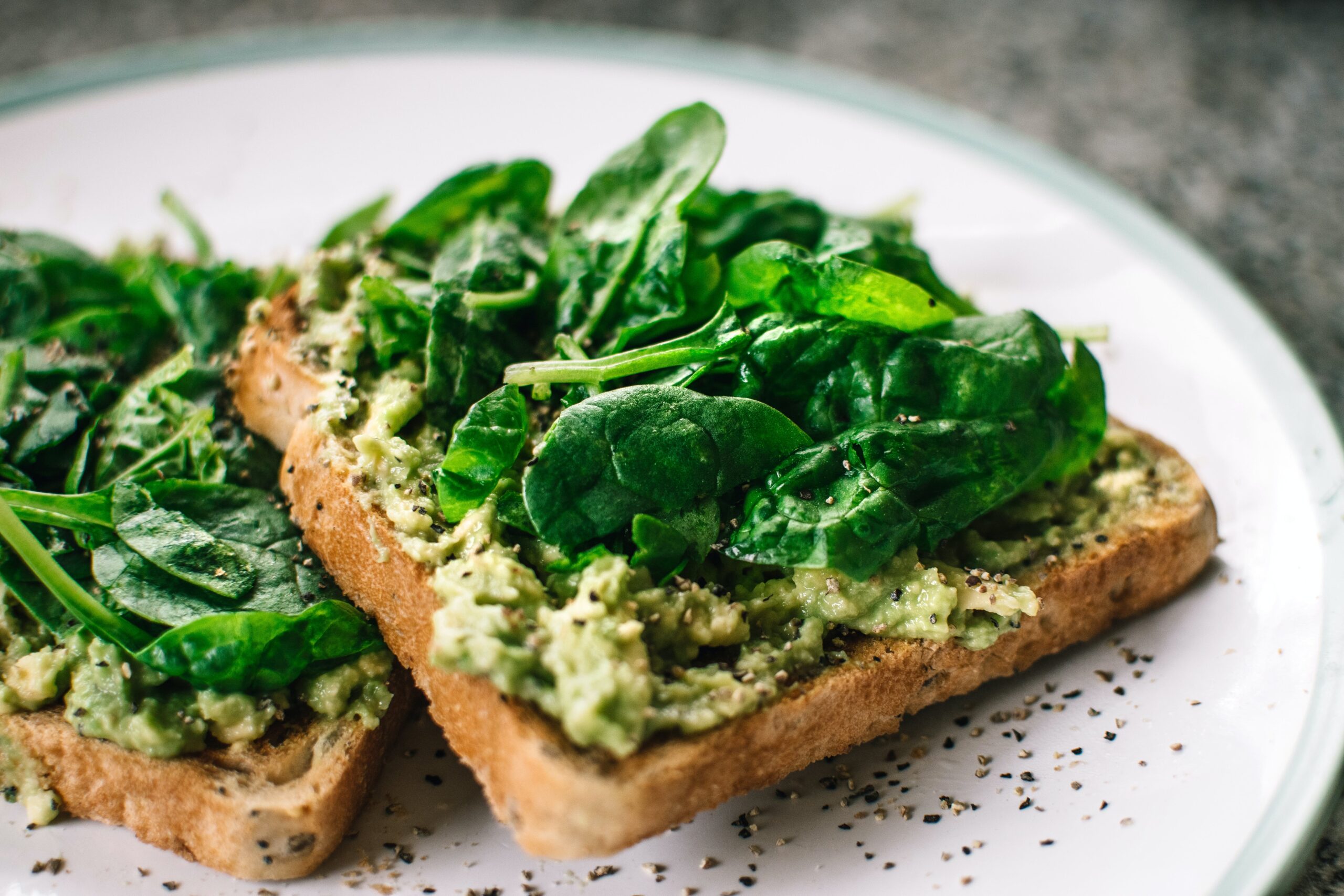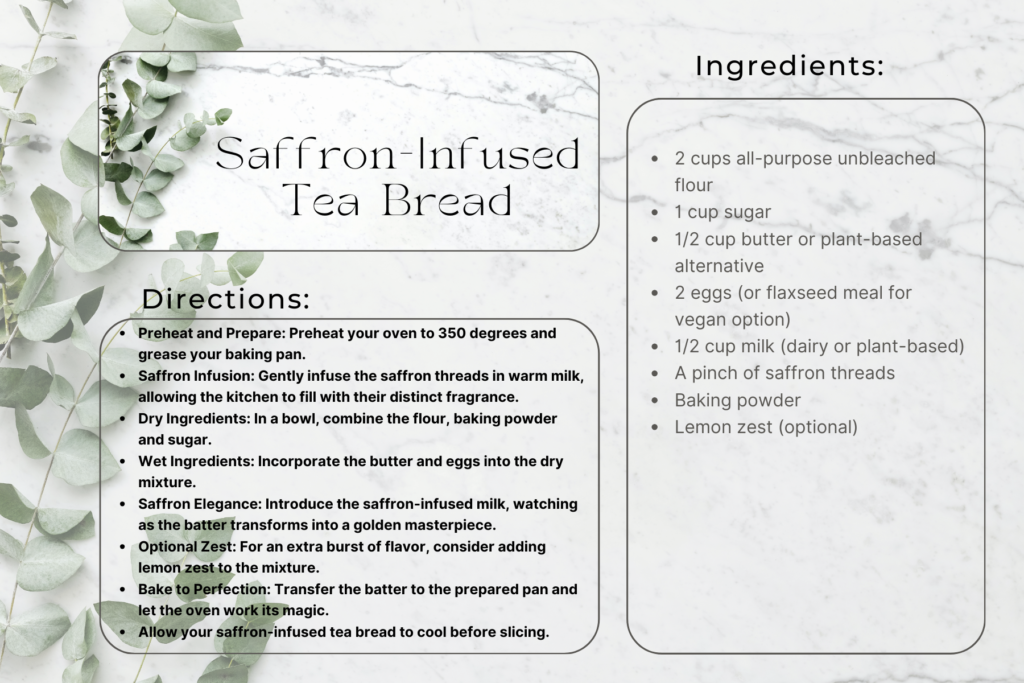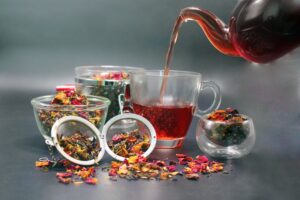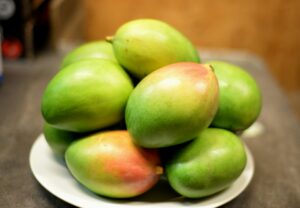Imagine the comforting aroma of freshly baked bread filling your kitchen, promising warmth and a moment of respite. Now, picture elevating that experience with a touch of luxury—enter our Saffron-Infused Tea Bread. This isn’t just any tea bread; it’s a delightful fusion of flavors where the richness of saffron weaves its magic into every bite. As we embark on this culinary journey, let’s explore not only the art of baking but also the potential emotional well-being benefits that saffron brings to this indulgent treat.
Tea bread has long been a symbol of comfort, a companion to quiet afternoons and cherished gatherings. In this recipe, we take the tradition a step further by infusing it with saffron, a spice celebrated not only for its distinct taste but also for its potential impact on emotional health. Before we delve into the kitchen, let’s uncover the tale of saffron and its transformative touch on this classic bread recipe. Get ready to bake your way to both sensory satisfaction and emotional nourishment.
Saffron-Infused Tea Bread
Ingredients:
2 cups all-purpose unbleached flour
1 cup sugar
1/2 cup butter or plant-based alternative
2 eggs (or flaxseed meal for vegan option)
1/2 cup milk (dairy or plant-based)
A pinch of saffron threads
Baking powder
Lemon zest (optional)
The Star of the Show-Saffron
Before we dive into the method, let’s take a moment to appreciate the star of the show—saffron. This vibrant spice not only imparts a golden hue but also carries with it a rich history and potential emotional well-being benefits.
The Tale of Saffron’s Transformative Touch:
In the realm of culinary enchantment, few ingredients possess the mystique and allure quite like saffron. Derived from the delicate stigma of Crocus sativus flowers, saffron not only imparts a distinctive golden hue to dishes but also weaves an intricate tale of history, luxury, and potential well-being benefits.
Golden Threads of History: Saffron’s story unfolds across centuries, tracing its origins to ancient Persia, where it was prized not only for its flavor but also for its vibrant color. As trade routes expanded, saffron’s influence permeated diverse cuisines, leaving its mark on dishes from Spanish paella to Indian biryanis. The rarity of the saffron crocus, requiring meticulous hand-harvesting, further enhanced its value, earning it the title of “red gold.”
A Symphony of Flavor and Aroma: In our Saffron-Infused Tea Bread, saffron plays the role of both artist and alchemist. As the saffron threads gently infuse in warm milk, they release a symphony of flavors—subtle, earthy, and slightly floral. These golden threads transform the ordinary into the extraordinary, elevating the humble tea bread to a culinary masterpiece.
Saffron and Emotional Well-Being: Beyond its culinary prowess, saffron carries a reputation for potential emotional well-being benefits. Studies suggest that compounds in saffron may have mood-enhancing properties, offering support for individuals grappling with symptoms of depression and anxiety. As we incorporate saffron into our tea bread, we not only celebrate its rich heritage but also invite a touch of emotional warmth to our baking ritual.
A Therapeutic Treat for the Soul: For those navigating conditions like ADHD, bipolar disorder, or experiencing rejection dysphoria, the addition of saffron in our tea bread becomes more than a culinary choice; it becomes a gesture of self-care. The act of baking, combined with the potential uplifting properties of saffron, transforms this treat into a therapeutic indulgence—a moment of tranquility and nourishment for the soul.
In every golden thread of saffron lies a tale of resilience, craftsmanship, and the ability to turn the ordinary into the extraordinary. As you embark on the journey of baking our Saffron-Infused Tea Bread, let the transformative touch of saffron remind you that every kitchen adventure is an opportunity to infuse joy and warmth into your culinary creations.
Article Continues Below
Saffron-Infused Tea Bread
AllNaturWell.com is a participant in the Amazon Services LLC Associates Program. Read Our Full Disclaimer Here
Elevate your home baking experience with the Elite Gourmet EBM8103B Programmable Bread Maker Machine. Designed for simplicity and versatility, this bread maker brings the art of artisan bread right to your kitchen, making the process foolproof and automatic.
Saffron-Infused Tea Bread
Article Continues Below
Instructions: Now, let’s embark on the journey of creating our Saffron-Infused Tea Bread. Follow these steps to bring this aromatic creation to life:
- Preheat and Prepare: Preheat your oven to 375 degrees and grease your baking pan.
- Saffron Infusion: Gently infuse the saffron threads in warm milk, allowing the kitchen to fill with their distinct fragrance.
- Dry Ingredients: In a bowl, combine the all-purpose flour, baking powder, and sugar.
- Wet Ingredients: Incorporate the butter (or plant-based alternative) and eggs (or flaxseed meal for a vegan option) into the dry mixture.
- Saffron Elegance: Introduce the saffron-infused milk, watching as the batter transforms into a golden masterpiece.
- Optional Zest: For an extra burst of flavor, consider adding lemon zest to the mixture.
- Bake to Perfection: Transfer the batter to the prepared pan and let the oven work its magic.
- Golden Brown and Irresistible: Once baked to a golden brown perfection, let your saffron-infused tea bread cool before slicing.
As your kitchen fills with the irresistible aroma, anticipate the moment when you can savor the melding of saffron’s warmth with the comforting embrace of freshly baked bread.
Optional Additions: For those seeking an extra layer of citrusy delight, consider adding a touch of lemon zest. This optional addition not only complements the saffron but adds a zesty twist to your tea bread, enhancing both flavor and aroma.
Disclaimer: The information and/or products mentioned in this article are provided as information resources only and are not to be used or relied on to diagnose, treat, cure or prevent any disease. The statements made in this article have not been evaluated by the Food and Drug Administration. Any products mentioned are not intended to diagnose, treat, cure, or prevent any disease, but rather to be considered as an informational resource only to encourage critical thinking and personal research. The information in this article is intended for educational purposes only. The information is not intended to replace medical advice offered by licensed medical physicians. Please consult your doctor or health care practitioner for any and all medical advice.






